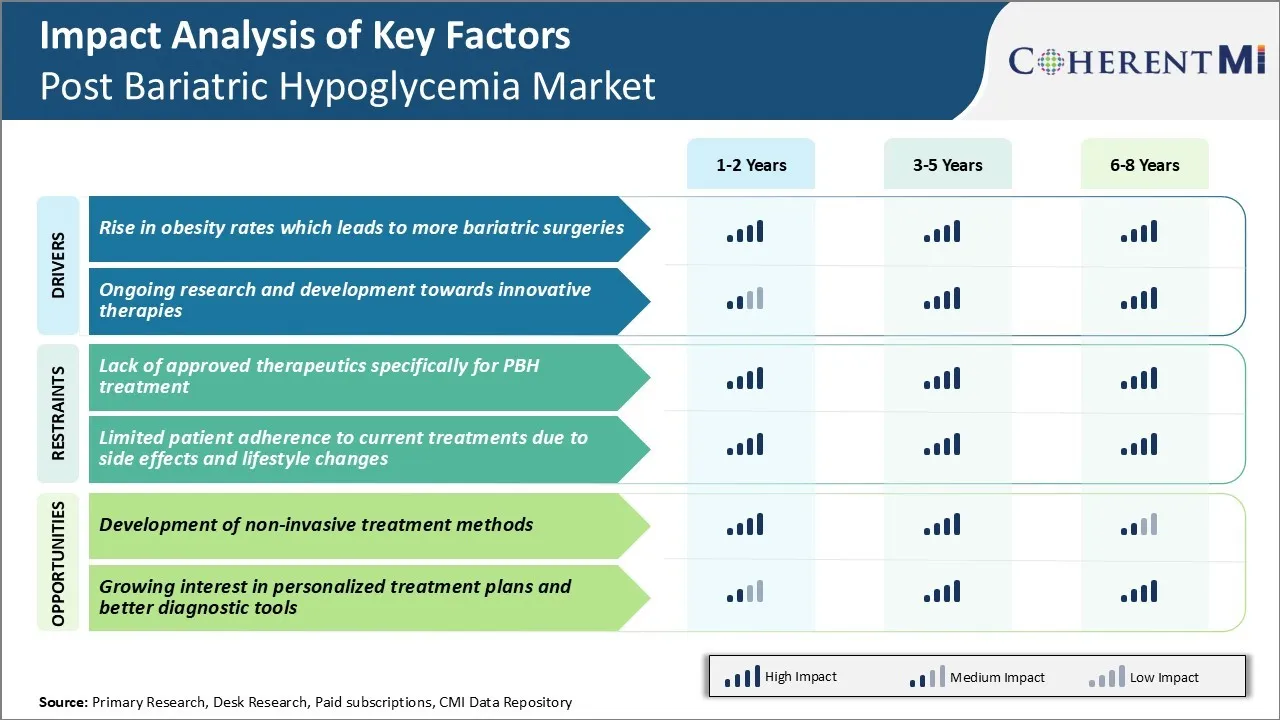Post Bariatric Hypoglycemia Market Trends
Market Driver - Rise in Obesity Rates Which Leads to More Bariatric Surgeries
Data indicates obesity levels have doubled globally since 1980. Over 650 million adults and over 340 million children and adolescents are now considered obese. As obesity rates rise, so do risks of associated health conditions like type 2 diabetes, cardiovascular diseases and certain cancers. Faced with acute health risks and limited efficacy of conservative weight management methods, more obese individuals are now opting for bariatric surgical procedures.
Growing acceptance and preference for minimally invasive techniques has further spurred adoption rates. Technological advancements are also enabling surgeons to perform complex procedures through small incisions using advanced instruments, robotic methods, and laparoscopy instead of traditional open surgeries.
However, a potential side effect of some bariatric procedures especially Roux-en-Y gastric bypass is postprandial hypoglycemia or low blood sugar episodes after eating. Estimates suggest almost 15% to 30% of patients experience symptomatic hypoglycemia post-surgery which can negatively impact quality of life if untreated.
This has led to a rise in demand for medications and therapies aimed at safely managing blood glucose levels in post bariatric patients. In turn, it is expected to drive growth for the post bariatric hypoglycemia market in the coming years.
Market Driver - Ongoing Research and Development Towards Innovative Therapies
Several pharmaceutical companies and research organizations are actively investing in the development of novel drug formulations and devices targeting post bariatric hypoglycemia. Innovators are exploring new molecular entities, drug delivery mechanisms and responsive monitoring tools to manage this condition more effectively.
Research is also evaluating modified oral sugar formulations for rapid glucose elevation during hypoglycemic crisis. Hydrogels and other polymer-based drug delivery platforms are being optimized to rapidly hydrate and release sugars specifically in the upper small intestine for faster absorption. Wearable glucose monitors linked to glucagon autoinjectors or insulin pumps hold promise for automatic intervention based on real-time trend analysis without user input.
The sizable patient pool affected by this disorder and unmet need indicates significant commercial opportunities for first-movers. Companies investing substantially in clinical studies, partnerships and technology access programs will be well placed to benefit as innovative new options become available for post bariatric hypoglycemia management in the coming years.

Market Challenge - Lack of Approved Therapeutics Specifically for Treatment
There is currently a lack of approved therapeutics specifically indicated for the treatment of post bariatric hypoglycemia. While off-label usage of some existing diabetes drugs are common treatment approaches, these are not formally approved or tested specifically for patients.
Due to the rarity of the condition and low commercial potential, pharmaceutical companies have not actively developed or conducted large clinical trials needed for regulatory approval of treatments. This leaves clinicians and patients with limited treatment options and forced to use medications off-label or rely on lifestyle managements for long-term control of hypoglycemic symptoms.
Developing disease-specific therapies requires significant investments in research and clinical development. Overall, risks associated with rare disease drug development often deters capital allocation by companies. This poses a major challenge for players in the post bariatric hypoglycemia market.
Market Opportunity - Development of Non-invasive Treatment Methods
Post bariatric hypoglycemia market presents an opportunity for developing non-invasive treatment methods. Current treatment approaches either rely on adjusting lifestyle and diet or using medication regimen requiring patient compliance.
Development of non-invasive technologies that can help monitor glucose levels is gaining traction. Focus is also on ways to deliver insulin through routes like oral, pulmonary, or transdermal administration. Such innovative treatment approaches could achieve better glycemic control. They can also improve patient quality of life by limiting discomfort or complications from invasive monitoring or frequent parenteral administration.
Non-invasive methods also address poor adherence issues associated with lifestyle changes or regimen complexity. The post bariatric hypoglycemia market is seeing advancements in continuous glucose monitoring, wearable drug delivery, and intestinal permeability modulators.
Consequently, there is scope for generating novel formulations and combination product platforms specifically optimized for post-bariatric patients. This presents lucrative commercial opportunities in the post bariatric hypoglycemia market by addressing significant unmet needs with novel treatment modalities.